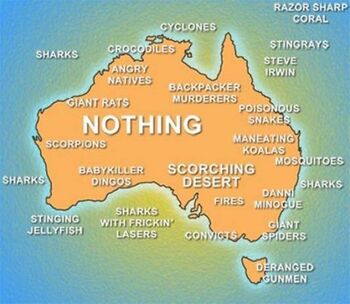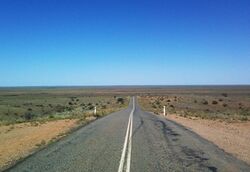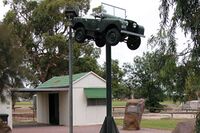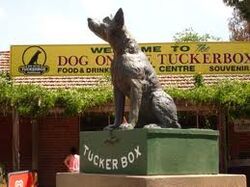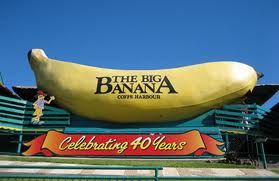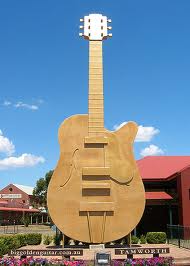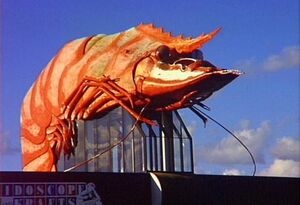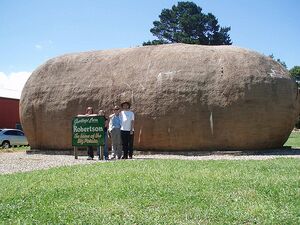Great Australian tourist destinations
You’ve seen it on Oprah. You vaguely remember seeing it on a map somewhere when you were ten. You might have even seen it in awful crocodile-themed films produced in the eighties. So why not see it with your own eyes? Release the shackles of the nine-to-five rat race and take a trip down under, or if you’re stationed on the Antarctic base, up over, or if you’re South American, due west. How about you just head in whichever colloquially-named compass bearing that applies to your nation of residence and come on down to Australia. Or is that come on left? Nevermind.
Due its considerably large geographical area and relative abundance of nothingness, not to mention the various poisonous marsupials, reptiles, mammals and plants, it is advised that international tourists develop a clear itinerary. By doing this, we can maximise sales of toy Koalas, Kangaroo T-Shirts and cheap boomerangs your holiday will be efficient and cheap, and you’ll avoid a fate worse than death: getting lost in the Outback with no food or water. Or even worse — getting stuck in Adelaide.
Getting in
Before gaining access to the landmass that is Australia, potential visitors must first go through a rigorous Visa application process. This is generally considered quite easy, provided your epidermis is beige in colour. Upon arrival, a visitor’s history will be checked for any criminal convictions. Don’t worry if you haven’t got one, customs will supply you one free of charge. Australia is renowned for its sunny beaches, however, Indian tourists are advised to ensure that when packing, towels are placed inside a suitcase and not situated on top of one’s head, as this may lead to a refusal of entry.
As part of strict new immigration laws, all visitors from non-English-speaking countries must pass a simple oral test of their vocal skills. If it is deemed the participant has excellent command of the English language, they’re forced to chug beer until sufficient slurring renders them comprehensible to locals.
If one wishes to gain entry into Australia but doesn’t possess the necessary paperwork, there is a more delicate method of entry. Simply board one of the many pleasure cruises departing Sri Lanka at convenient regular intervals. Try not to stress about the amount of viewing holes installed in the hull, as suitable bail buckets are numerous and well positioned, and in the unlikely case of the boat capsizing, anti-whale harpoons are available from the on-board gift shop.
The Outback
The Outback is a colloquial term often used to refer to the region of Australia that is out the back, or more accurately, the interior. Because of its misleading name, tourists often experienced difficulty locating it, which forced the Australian Government to recently change its name to Over There. Unfortunately, the new moniker merely continued the confusion as tourists were incorrectly travelling over there instead of to Over There.
The Outback, or Over There, possesses a wide array of wildlife that will amuse and poison adults and children alike. These include brown snakes, kangaroos, green snakes, wombats, yellow snakes, dingoes, black snakes, emus, tree snakes, stingrays and One-Eyed Trouser Snakes. And also regular snakes.
The Outback is a land of great contrast. From its vast desert featuring little shrubbery to its vast desert with medium-density shrubbery, visitors can expect to marvel at the scenery without fear of boredom — which is a great thing, considering towns are at least a four hour drive apart. It's also quite hot, but not in the sexy meaning of the word. It's rumoured that some people may have had sex there, however there remains little evidence of these occurrences.
Children will have a great time at the participation-based “Mine-seums”, where they can learn to appreciate the Earth’s natural resources by spending an intensive fortnight-long fun camp excavating their very own magnesium, copper and nickel ores for export to India and China. It’s not all about the kids though. While the kids are off playing in the mines, parents can go on a journey of discovery to unmapped parts of pristine desert where, hopefully, they will stumble upon an undiscovered Aboriginal tribe and be the very first Westerners to bastardise their culture and introduce smallpox.
The Big Pineapple
Queensland’s Big Pineapple is famously known for being Australia’s largest fruit-themed tourist attraction; it’s also infamous for being the country's fourth-largest structure made entirely out of asbestos. Standing over sixteen metres tall, and six metres wide, it is nine metres taller than Spain’s Medianas piña, and is 95% less sexually suggestive than Coffs Harbour's Big Banana. Built in 1971, the large fruit was originally designed as a means for scaring fat kids away from the local candy factory. While diabetes has long since taken care of the fat kids, the pineapple has developed into a Mecca for tourism, or more accurately, a Mecca for misguided Muslim pilgrims.
Tourists aren’t easily amused, and that’s why the designers of the Big Pineapple integrated an internal stairway that leads to a lookout point amongst the leaves. Once they’ve reached the pinnacle, enthusiastic tourists can then experience a full 360-degree panoramic view of the infrequently cleaned summit of the Big Pineapple.
Sadly, in 2009, the Big Pineapple was put into receivership after racking up debts of over half a million dollars. Although it’s surprising a pineapple could muster up that much debt, it is rumoured to have been a problem gambler. The pineapple was subsequently sold to a leading local juice manufacturer and is currently undergoing extensive remodeling of the site. In the interim, visitors are able to purchase smaller pineapples at the gift shop. These can be held up close to a camera lens while taking a photo, thus giving the appearance that the person in the photo is standing next to a rather large pineapple.
Uluru
Uluru, literally meaning big rock in the local Aboriginal tongue, is a big rock. In fact, it’s a really big rock. Not so big as to be labelled a mountain, yet too large for molehill status; Uluru is the biggest rock in the world. Probably.
Ancient Aboriginal documents clearly state Uluru was created during the Dreamtime by the Rainbow Serpent. As the story goes, the Rainbow Serpent rose from beneath the Earth to carve it out of a slightly larger rock. Not content with its lethargic cropping effort, the Rainbow Serpent became bored and decided to create the many overpriced and tacky souvenir stores and hotels that litter the area around Uluru.
Tourists should be aware of certain cultural sensitivities that are held by the traditional land owners, the Anangu people. Taking photos of certain areas of Uluru is strictly forbidden. These include areas that are linked to sacred gender-related rituals, and the large plantation of herbs around the back covered by a huge army-camouflaged tent. Recent stories also tell of a curse that befalls those that attempt to smuggle out large souvenir rocks in their backpacks. In an ironic twist of fate, the curse inflicts musculoskeletal injuries around the spinal area which are similar to those caused by lifting heavy weights. These injuries can only be mended once the stolen rocks are removed from the backpack and returned to their original place — followed by extensive surgery.
Land rover on a Pole
Situated in the captivating little town of Keith in the southeast corner of South Australia, is the Land Rover on a Pole. As its name implies, it consists of a Land Rover situated on a long, hard erection that most people would commonly identify as a pole. The Land Rover is an early model, has a manual transmission and four wheels, is in immaculate condition, comes with a fully-operational steering column, and has only had only one previous owner — a little old lady who never drove it, except to church on Sundays. Connected to the Land Rover is a pole. The pole has a Land Rover on it.
The townsfolk of Keith share a fascinating little story about the origins of the Land Rover on a Pole that is shrouded in mystery, suspense, and major plot holes, and often features somewhat unnecessary sex scenes. Here's an abridged version: in the 1950’s, the town of Keith and its surrounding districts took part in a land-clearing scheme and decided to celebrate it. Not having much else to celebrate, they decided to celebrate their feats of land clearing with...a Land Rover...on a pole.... I guess you had to be there.
The Land Rover on a Pole offers many great activities for people of all ages. Experience the simple pleasure of getting your picture taken with the Land Rover on a Pole. Stand and point at the Land Rover on a Pole. Have an in-depth discussion with a local publican on the politics of Postmodernism while relating your key arguments back to the Land Rover on a Pole’s symbolic nature, and then spend four hours driving back home. Yup, the Land Rover on a Pole has got it all.
Luna Park
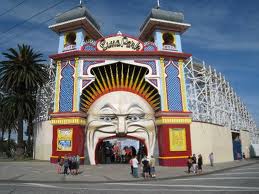
If you’re looking for an action packed, affordable and memorable way to entertain the kids while holidaying in Melbourne then look somewhere else. If your standards aren’t quite so high, then a short trip to the lovely bay-side suburb of St. Kilda to the iconic Luna Park is just the medicine you need.
Although the park itself is quite small, tedium-related fatigue makes it impossible to see it all in one day. Some of the more discerning visitors might consider it a blessing, though, as most of the park is in a state of disrepair and/or covered in the unsightly result of mixing too much fried food with stomach acids and centrifugal forces.
Surrounding the vast grounds of Luna Park is the 99-year-old traditional wooden roller coaster, its main tradition being the systematic lack of maintenance by park staff for most of its existence. Roaster coaster enthusiasts will literally fear for their lives as the early twentieth-century carriages whisk them around at a brisk walking pace, giving riders ample time to view the many missing nuts, bolts and vertical support struts long lost to the ravages of time. The “scenic railway”, as it is rarely known, completely surrounds the perimeter of Luna Park, making it Melbourne’s highest vantage point — for viewing the roads surrounding Luna Park. Fortunately for those weak in the knees and highly susceptible to nausea-related regurgitation, the price of a ticket excludes all but the wealthiest suicidal manic depressives.
Dog on a Tuckerbox
Located a short seven-hour drive from Sydney, the Dog on a Tuckerbox is a well-known bronze sculpture of a dog sitting on a tuckerbox, an Australian colloquialism for a rectangular metal container commonly used to store one’s tucker.
Like much of Australia's early folklore, the origins of the Dog on the Tuckerbox are clouded in mystery, uncertainty, and controversy, and are as boring as bat shit. The statue was inspired by an early Australian poem written by Bowyang Yorke, titled Dog on a Tuckerbox, which retells the fictional adventures of a bronze sculpture of a dog sitting on a tuckerbox. Being a poem, nobody bothered to actually read it, but once film director Jack Moses turned it into a motion picture, it captured the imaginations of Australians who fell in love with the story, presumably since nothing else was on TV at the time.
Each year, an annual Dog on the Tuckerbox Festival is held in the nearby town of Gundagai. Over the course of two days, the festival attracts several dozen people who delight in staring at a dog on a tuckerbox. The local McDowell's restaurant also sells a special Dog on a Tuckerbox happytime meal, served inside a replica steel tuckerbox complete with a real dog guarding its contents. For those who can't afford a camera and still wish to cling to their treasured holiday memories, the local metal workers can turn your pet dog into your very own lifelike bronze statue. However, the dog is lost in the process.
More must-see big stuff
With the small exception of Giantsville, everything’s bigger in Texas. But that hasn’t stopped many small Australian communities from pooling their collective brain power together and coming up with ideas for a litany of big crap in order to put their town on the map. For the intrepid traveller, here is a small taste of what can be found off the beaten track &mash; well, apart from the dead bodies of foreign backpackers, that is.
The Big Banana
Although this popular site’s operators boastfully claim, “It’s a whole bunch of fun”, sightseers are often disappointed by the fact there is only one Big Banana. This, however, does not detract from the fact that the Big Banana is a big banana. Tickets are relatively cheap and can be bought separately or as part of a family fun pass. These are somewhat redundant, though, as frugal travellers can observe the banana for free by looking out their car windows as they travel along the nearby highway.
The Big Guitar
The Big Golden Guitar is the main attraction of the Big Golden Guitar Tourist Centre situated in the country music capital of Australia, Tamworth. Woodworking enthusiasts will admire the craftsmanship of its subtle basswood body and sleek rosewood neck uniquely fixed with nails and PVC glue. Guitar enthusiasts may notice a distinct lack of a functional bridge, strings or a pickup, which may decrease playability somewhat.
The Big Prawn
Sometimes called The Big Shrimp, there is nothing small about this wacky tourist trap, with perhaps the exception of enjoyment levels. The origins of the Big Prawn are a complete mystery, mainly due to the fact that no one is willing to admit to building the thing. Situated under the Big Prawn is an average-sized cafeteria. Although they don’t serve giant prawns as part of their lunch menu, they do, however, serve up large doses of salmonella and E. coli with every meal.
The Big Potato
You say potato, I say potahto, some say potarter, others say giant concrete turd, but the people of Robertson, NSW, home of the Giant Potato, just apologize profusely.
See Also
| Featured version: 29 January 2012 | |
| This article has been featured on the main page. — You can vote for or nominate your favourite articles at Uncyclopedia:VFH. | |
